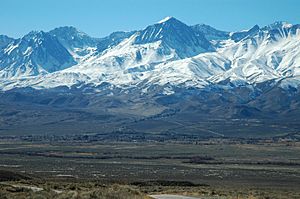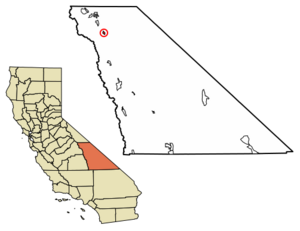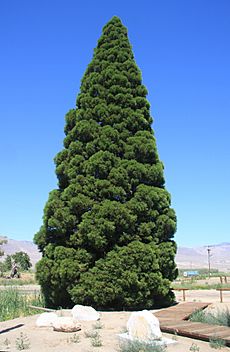Big Pine, California facts for kids
Quick facts for kids
Big Pine
|
|
|---|---|

Big Pine in the Owens Valley, Sierra Nevada behind
|
|

Location in Inyo County and the state of California
|
|
| Country | |
| State | |
| County | Inyo |
| Named for | A large pine tree that had been growing in the town in 1870 |
| Area | |
| • Total | 2.95 sq mi (7.64 km2) |
| • Land | 2.95 sq mi (7.64 km2) |
| • Water | 0.00 sq mi (0.00 km2) 0.065% |
| Elevation | 4,019 ft (1,225 m) |
| Population
(2020)
|
|
| • Total | 1,875 |
| • Density | 635.81/sq mi (245.53/km2) |
| Time zone | UTC-8 (Pacific (PST)) |
| • Summer (DST) | UTC-7 (PDT) |
| ZIP code |
93513
|
| Area codes | 442/760 |
| FIPS code | 06-06616 |
| GNIS feature ID | 2407843 |
Big Pine is a small community in Inyo County, California, USA. It's about 15 miles (24 km) south of Bishop. In 2020, about 1,875 people lived there. The town is named after a large pine tree that grew there in 1870. The Big Pine Band of Owens Valley Paiute Shoshone Indians has its main office here.
Contents
Exploring Big Pine's Location
Big Pine is in the beautiful Owens Valley of California. It sits between two large mountain ranges: the Sierra Nevada and the White Mountains. The Owens River flows nearby.
The town is on U.S. Route 395. This is a major road that goes north and south through the Owens Valley. It connects places like the Inland Empire to Reno, Nevada. You can also reach Los Angeles from Big Pine using this road and State Route 14.
Mountains and Nature Around Big Pine
To the east, CA Route 168 crosses the White Mountains. This road goes over Westgard Pass and leads to Nevada. Another road, Death Valley Road, takes you to Death Valley.
A special giant sequoia tree, called the Roosevelt Pine, was planted in 1913. It marked the opening of Westgard Pass for cars. Sadly, this tree was removed in 2020 because it was dying from a lack of water. North of Westgard Pass is the Ancient Bristlecone Pine Forest. This forest is home to some of the oldest trees in the world!
To the west, Glacier Lodge Road goes high into the Sierra Nevada mountains. It follows Big Pine Creek. Here, you can find lakes, hiking trails, and great spots for fishing and rock climbing. These areas are near the amazing Palisades Range and the Palisade Glacier.
Big Pine covers about 3 square miles (7.6 square kilometers) of land. Most of this area is land, with very little water.
Big Pine's Past
The Big Pine post office first opened in 1870. It closed for a short time in 1877. Its name changed to Bigpine in 1895, then back to Big Pine in 1962.
Big Pine is near a special land feature called an earthquake scarp. This was created by the big 1872 Lone Pine earthquake.
In 1958, the Owens Valley Radio Observatory was built just north of Big Pine. This is a place where scientists study space using radio telescopes.
Some famous people have lived in Big Pine. Matt Williams, a professional baseball player and manager, lived here for a while. Also, Hollywood actor Elisha Cook, Jr., known for movies like The Maltese Falcon, had a home in Big Pine and passed away there in 1995.
People of Big Pine
| Historical population | |||
|---|---|---|---|
| Census | Pop. | %± | |
| 2000 | 1,350 | — | |
| 2010 | 1,756 | 30.1% | |
| 2020 | 1,875 | 6.8% | |
| U.S. Decennial Census | |||
In 2010, Big Pine had 1,756 people. Most residents were White (67.9%). A large part of the population was also Native American (24.9%). About 10.4% of the people were Hispanic or Latino.
The average age of people in Big Pine in 2010 was 46.6 years old. About 19.4% of the population was under 18 years old.
In 2000, there were 1,350 people living in Big Pine. The average household had about 2.29 people. The median income for a family was $46,094.
Big Pine students go to schools in the Big Pine Unified School District. This district has an elementary school, a middle school, and a high school. The high school's mascot is the Warrior.
A Landmark Case: Piper v. Big Pine (1924)
In 1923, a very important event happened in Big Pine. Alice Piper, who was 15 years old and Native American, wanted to go to the Big Pine school. However, she was not allowed because of her ethnicity. At that time, California had a law that allowed separate schools for "Indian children" and other children of Asian background.
Alice Piper's father, Pike Piper, paid taxes and was a citizen. Because of this, Alice sued the school district. She argued that the state law was unfair and went against her rights.
The highest court in California, the State Supreme Court, agreed with Alice. They said that because her father was a tax-paying citizen, Alice also counted as a citizen. This meant she had the right to attend public schools.
This victory, along with a new law called the Indian Citizenship Act, helped Alice and other Native American children go to public schools in California. The Big Pine School District became known for its role in this important legal fight. It helped make sure Native American children could attend schools that were once only for "whites."
The Piper case is now a famous example in history. It helped guarantee Native American children the right to attend public schools. It has even been used as a guide in other important cases, like Brown v. Board of Education, which ended school segregation across the United States.
See also
 In Spanish: Big Pine para niños
In Spanish: Big Pine para niños



